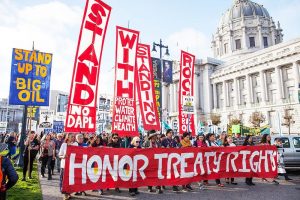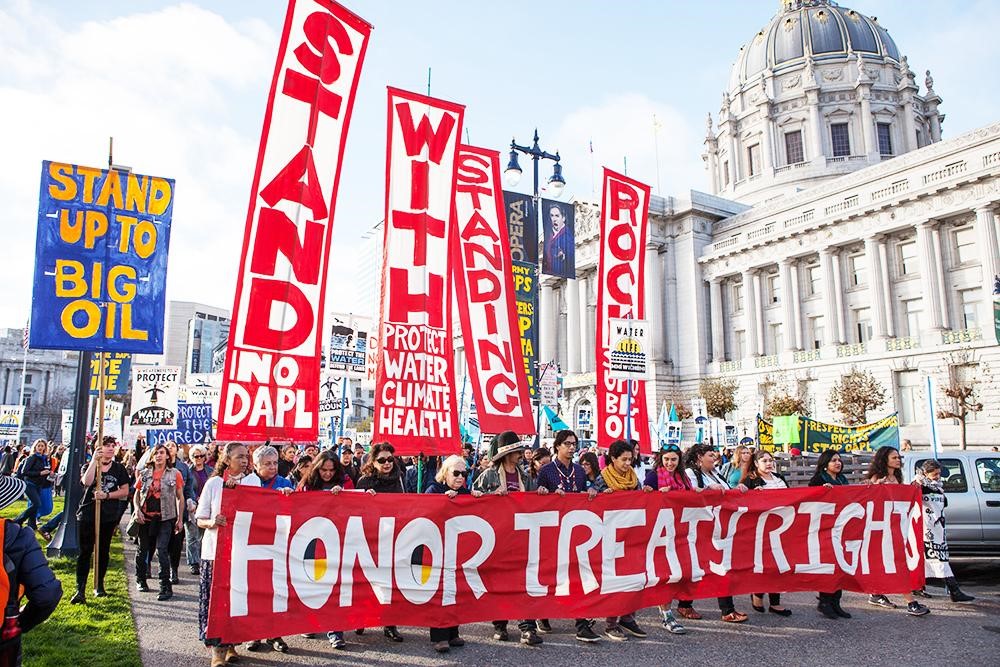 By: Haley Edmonds
By: Haley Edmonds
The Indigenous right of Free, Prior, and Informed Consent should be implemented in U.S. environmental decision-making substituting the current, lesser standard, of tribal consultation. By empowering Native Americans with actual leveraging power, and not merely a forum to air their grievances, Indigenous peoples can effectively serve as the last line of defense against environmentally-exploitative activities, such as pipelines.
What is FPIC?
Free, Prior, and Informed Consent (FPIC) is a communal right recognized by international law that grants Indigenous communities veto powers in decision-making processes affecting their land and people.[1]
The right of Free Prior and Informed Consent was officially enshrined into international law through The United Nations Declaration on the Rights on Indigenous Peoples (UNDRIP). [2] The declaration did not create new rights for indigenous peoples, but rather elaborated on existing human rights principles of international law, such as the indigenous right of self-determination.[3]
UNDRIP requires nations to obtain FPIC “prior to the approval of any project affecting [Indigenous] lands or territories and other resources[4], particularly in connection with the development, utilization or exploitation of mineral, water or other resources”[5] FPIC also applies when indigenous peoples’ cultural, intellectual, political, religious, or spiritual property is infringed upon, though the environmental decision-making component will be the central focus of this article.[6]
If FPIC is triggered, public and private developers must negotiate with the affected tribe(s) at every step of the development process, and cannot proceed until a settlement has been reached.[7] Because FPIC is a collective right, the entire indigenous community must reach an informed decision together.[8]
While UNDRIP is not binding law, 147 countries have since adopted it into their respective legal instruments.[9] The United States is not one of these countries. The U.S. currently only requires the weaker standard of tribal consultation in environmental decision-making, though talk of integrating FPIC has arisen in prominent liberal documents such as the Green New Deal.[10] Unlike consent, which requires tribal approval before a project can begin, consultation only calls for the “regular and timely input of tribal officials.”[11] Therefore, even if tribes vehemently oppose the project, so long as developers discuss their plans with the affected tribes and submit a summary of this discussion, the duty of consultation has been satisfied.[12]
The primary contention that stands in the way of FPIC is its applicability. Opponents believe that FPIC is still shrouded by ambiguity. However, most of this ambiguity is in fact created by these opponents.[13] For example, leaders continuously debate the meaning of “consent.”[14] While a plain meaning of requiring free and informed consent “prior to” undertaking “any project affecting [indigneous land]” tends to imply that indigenous peoples have the power to veto a project’s construction by withholding their consent, opponents have repeatedly tried to water-down this right by construing consent as merely a form of consultation.[15] While opponents paint this debate as “ambiguity,” such differing interpretations do not seem to arise so long as protecting the humanity and sovereignty of indigenous peoples remains the priority. [16]
Why is it important?
Not only should FPIC be adopted in the United States because it is globally recognized as a right that indigneous peoples are entitled to and can help to restore some of the sovereignty that the federal government has unlawfully stripped from Native Americans over the course of our nation’s history, FPIC should be implemented because it is an effective mechanism for environmental protection.
Indigenous peoples across the world are distinguished by their deep relationship with the land.[17] Ecosystem protection is an essential way of life for indigenous peoples, and the traditional ancestral knowledge that they have acquired from this close relationship has enabled them to devise a rich treasury of climate change mitigation and adaptation strategies.[18] Indigenous peoples have long been active participants in global environmental development and climate change conferences,[19] and front-line leaders of environmental advocacy movements.
One famous advocacy movement was initiated by the Standing Rock Sioux Tribe in opposition to the Dakota Access Pipeline.[20] Despite this fierce indigenous opposition, the project was approved, and said to have met the requisite consultation requirements. [21] It is argued that construction on this pipeline would never have begun should FPIC have been in effect.[22]
The Sioux tribe sued the pipeline, arguing that such minimum consultation requirements were not sufficient,[23] and even appealed to the UN to enforce FPIC under UNDRIP.[24] However, this claim was not successful, as courts failed to acknowledge foundational claims of self-determination. [25]
A similar advocacy movement is currently taking place here in Virginia. Since 2018, the Mountain Valley Pipeline has met opposition by several indigenous groups.[26] Such efforts to prevent construction have similarly failed, though the project continues to be contested.[27] Indigenous tribes have also brought similar claims against the pipeline, contesting the sufficiency of the minimum consultation requirements.[28] And similarly, the complaints have failed as courts continue to ignore indigneous rights to self-determination.[29] However, a change may be in store after the 2020 supreme court case Mcgirt v. Oklahoma, which expanded the United States’ recognition of tribal sovereignty.[30] Should this momentum continue, the integration of FPIC in the U.S. may be made a reality, and environmentally-exploitative projects such as the Mountain Valley Pipeline may be thwarted by this additional line of defense.[31]
[1] Guide to Free Prior and Informed Consent, Oxfam 1, 9 (2010), https://www.culturalsurvival.org/sites/default/files/guidetofreepriorinformedconsent_0.pdf, hereinafter FPIC Guide.
[2] United Nations Declaration on the Rights on Indigenous Peoples, United Nations, Article 32 (Sept. 13, 2007) [hereinafter UNDRIP].
“Free” requires that there be no coercion or intimidation, “Prior” requires that consent be granted before any activity begins, “Informed” means that the consenter must be given sufficient information to reach their conclusion, and “consent” means that the indigenous community must explicitly agree to the project in question. Expert Mechanism on the Rights of Indigenous Peoples, Final report of the study on indigenous peoples and the right to participate in decision-making, Human Rights Council, U.N. Doc. A/HRC/18/42, at 25 (Aug. 17, 2001).
[3] Expert Mechanism on the Rights of Indigenous Peoples, Free, Prior and Informed Consent: A Human Rights-based Approach, Human Rights Council, U.N. Doc. A/HRC/18/42, at 2 (Aug. 17, 2001). Indigenous peoples have always had the inherent power to make binding agreements and decisions with other sovereigns. Id. This right to self-determination remains the law of the land in all places where this treaty-making process was undertaken, even where such treaties have been dishonored (e.g. the United States). Id.
[4] This includes activities happening off-reservation, if that activity affects the lands and people under tribal jurisdiction. George K. Foster, Community Participation in Development, 51 V and J. Transnat’t. L. 39, 73 (2018). For example, if an off-reservation project violated a tribe’s treaty rights to hunt and fish, or harmed culturally significant sites. Id.
[5] UNDRIP, United Nations, Article 32 (2007).
[6] Id. at Article 10, 11, 19, 29.
[7] Id. at 20.
[8] Id. at 23.
[9] FPIC Guide at 29.
[10] Green New Deal, 116 H. Res. 11, (Feb. 5, 2019) https://apps.npr.org/documents/document.html?id=5729033-Green-New-Deal-FINAL (“the Green New Deal will require… obtaining the free, prior, and informed consent of indigenous people for all decisions that affect indigenous peoples and their traditional territories”)
[11] Executive order 13175 (Nov. 6., 2000), https://www.govinfo.gov/content/pkg/FR-2000-11-09/pdf/00-29003.pdf.
[12] Id.; Nicholas A. Fromherz, From Consultation to Consent: Community Approval as a Prerequisite to Environmentally Significant Projects, 116 W. Va. L. Rev. 109, 110 (2013) (“By its very nature, consultation implies limited influence.”).
[13] Martin Papillon, et al., Free, Prior and Informed Consent: Between Legal Ambiguity and Political Agency, Int’l J. on Minority and Group Rights, 223 (2020), https://brill.com/view/journals/ijgr/27/2/article-p223_223.xml?language=en#FN000001.
[14]Brant Mcgee, The Community Referendum: Participatory Democracy and the Right to Free, Prior and Informed Consent to Development, 27 Berkeley J. Int’l L. 570, 591-93 (2009).
[15] Id.
[16] See Papillon at 229.
[17] Hindou Ibrahim, Indigenous Peoples and Climate Change, UN Permanent Forum on Indigenous Issues, 2 (2021), https://undocs.org/E/C.19/2021/5.
[18] Id.
[19] Id. 5-6.
[20] Melissa Mejia, The Dakota Access Pipeline, The Indigenous Foundation.
[21]Id.
[22] Kelsey Landau, On Indigenous Peoples Day, New Ideas for American Indian Land Rights, Brookings (2019), https://www.brookings.edu/blog/fixgov/2019/10/14/on-indigenous-peoples-day-new-ideas-for-american-indian-land-rights/.
[23] Standing Rock Sioux Tribe v. United States Army Corp of Eng’rs, 205 F. Supp. 3d 4 (D.C. Cir., Sept. 16, 2016) (Plaintiff argued that section 106 of the National Historic Preservation Act (NHPA) is insufficient, because it only requires developers to consult with tribes “to identify historic properties within the area of potential effects,” and allows developers to ultimately proceed with the project “despite the effects” if this consultation “becomes unproductive.”).
[24] Standing Rock Sioux Tribe and IITC file an Urgent Communication to the United Nations Citing Human Rights Violations Resulting from Pipeline Construction, Int’l Indian Treaty Council, (Aug. 16, 2016), https://d3n8a8pro7vhmx.cloudfront.net/honorearth/pages/2274/attachments/original/1472551280/IITC_Press_Release_Standing_Rock_August_19__2016rev1FINALFINAL.pdf?1472551280.
[25] Sophie Delfeus, The Suspended Battle at Standing Rock, Intercontinental Cry (Dec. 19, 2016), https://intercontinentalcry.org/suspended-battle-standing-rock/; See Id.
[26] Kevin Ridder, The Appalachian Pipeline Resistance Movement: “We’re Not Going Away”, Appalachian Voice, (Oct. 28. 2020),
[27] Another Legal Battle Looms Over Mountain Valley Pipeline, West Virginia Public Broadcasting, (Dec. 27, 2021), https://www.wvpublic.org/energy-environment/2021-12-27/another-legal-battle-looms-over-mountain-valley-pipeline.
[28] Appalachian Voices v. FERC, 2019 U.S. App. LEXIS 4803, 21 (D.C. Cir. Feb. 19, 2019).
[29] See id.
[30] 207 L. Ed. 2d 985, (July 9, 2020).
[31] It is important to note that Native Americans are not a monolith, and should not be expected to prevent all exploitative projects from taking place on their lands, especially in the face of fierce economic pressures. However, it is not unreasonable to believe that Indigenous peoples’ historic relationship with the land better equips them to make more environmentally-protective decisions than their immigrant counterparts.

